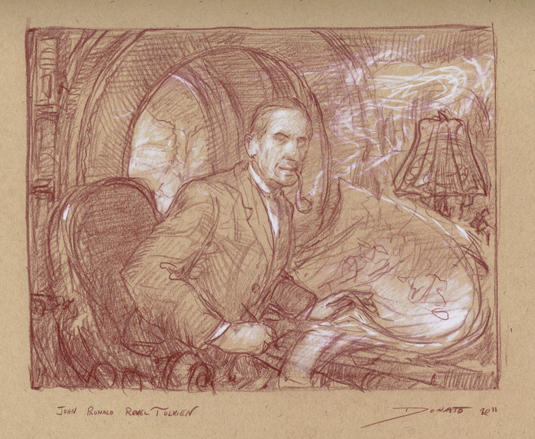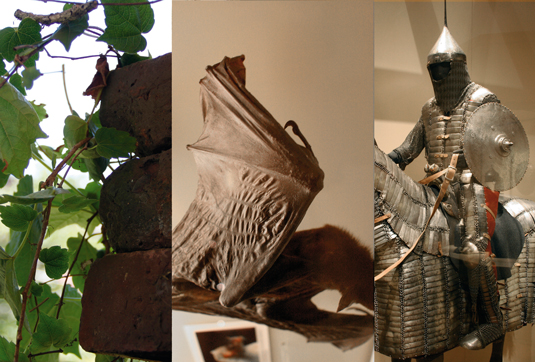Pro tips to help you find your inner artist
Donato Giancola reveals the secrets of his painting process and offers advice on getting creatively inspired and keeping your passion flowing.

From the beginning of my career as a young artist, the worlds of JRR Tolkien have inspired me to create art. From Frodo to Boromir to Saruman, I love to delve into their psyche and create images reflecting the turmoil and conflicts that rocked their world, and in a way mirror our own.
My earlier attempts at portraying the riches of Tolkien's writings had always fallen short, not just at the technical level but on the conceptual as well. Yet still I pushed on, for my love of the story overcame any limitations I felt in my artistic skills.
This, I feel, is the most important message for you to take away from this workshop: that although you may glean some wonderful new insight into how to improve your art, these images and words can never supplant the passion and belief you must have for your own personal visions.
Dig deep into what you love about your subject matter and find a way to express those innermost feelings. It's this passion that will drive you to new experiences, challenge you in discoveries and bring you the greatest joy – it should also be enough to sustain you through all the downturns.
I couldn't be the artist I'm today without the inspirational trail-blazing by previous artists. I've learned from the best of contemporary figurative realists through to the greatest of the Old Masters.
The following insights provide a distillation of what I've gleaned from these studies and illuminate my approaches to contemporary figurative narration, draftsmanship, aesthetics of abstraction and imaginative development. May they benefit your creative development as other such knowledge elevated my own work.
Enjoy the journey!
Daily design news, reviews, how-tos and more, as picked by the editors.
01. Abstracts

My image creation begins with play in abstract forms. I prime my mind with relevant literature or from visual experience. I'm never sure what I'm seeking, but let the shapes, lines and mental images lead me where they may. For this reason it's good to generate numerous compositions. Derivatives, experimentation and tangents eventually lead away from typical solutions
02. Rough drawing

After selecting an abstract composition, I begin to resolve how to populate the image with specifics. I prefer to work mostly from imagination at this stage, freeing decisions for compositional play of forms. I'll introduce challenges to the art here, pitching curveballs to my assumptions.
Can I use six instead of three figures? Rather than a simple colour field background, will an ornamental architectural structure work? What if a pattern of massive horizontal lines replaced that shape? Engineering the difficult into the drawing here creates a foundation that’s easier to build upon later.
03. Reference gathering

One of my favourite aspects of creating art is the research into props, costumes, environments, textures, architecture, character types, cultures and any other inspirations needed for elements in the illustration.
I seek out influences from other art forms – Islamic textile patterns, East African clothing, Chinese architecture, to name a few – and will purchase books loaded with references, if needed. Researching the diversity of the world in museums, libraries and on the streets of New York, and finding a way to weave it into my art, is what I love most about painting.
04. Models and acting

One of the cornerstones of my art is reference sessions with models in costumes. The interactions between people are highly complex and our imaginations can’t fathom them all. So I let my models act out the emotions and scene, given my parameters. The accidental tilt of a head, casting of a shadow, or flesh on flesh compressions are what I live for during these sessions. When you hit upon the perfect human engagement it can make a painting scream to life.
05. Cartoon – preliminary drawing

With all the reference material gathered and the rough composition and abstract studies nearby as guides, I then create a cartoon for the painting. A cartoon in this context is a large drawing produced at a 1:1 ratio to the final painting (a preparatory step I borrow from medieval and Renaissance artists, like Hans Memling and Michelangelo).
I begin sketching in vectors and volumes of shapes and progress by adding details from the photographs and observations I've made. This is a stage that enables quick experimentation in greys and abstract vector placement to determine movement, values, scale, lighting and composition.
Playing around in pencil saves me from hours of corrections that could occur in the final oil painting. The most critical concept to emphasise here is bending the reference to fit the will of your initial impulses in the abstract and rough drawings.
06. Falling in love

One of the most difficult aspects of working as a freelance artist is falling in love, so you can spend hours in the presence of that which you so desire – I'm not talking about another human here.
The amount of time we spend with our art is greater than any other relationship. If you dislike your project or commission, it can be a torment spending hours with it. Finding a way to personalise and make the art desirable is key to staying happy and inspired.
Sometimes it can be a little inclusion, like the face of a friend on a background character, or a pattern or lighting effect (here it's the drawings and manuscripts Tolkien used in the creation of his books). These inclusions force you to learn something new in the execution. Whatever it is, try to fall in love with your art, or at least offer it a little hug!
Next: 6 more tips to keep you passionate about drawing!

The Creative Bloq team is made up of a group of art and design enthusiasts, and has changed and evolved since Creative Bloq began back in 2012. The current website team consists of eight full-time members of staff: Editor Georgia Coggan, Deputy Editor Rosie Hilder, Ecommerce Editor Beren Neale, Senior News Editor Daniel Piper, Editor, Digital Art and 3D Ian Dean, Tech Reviews Editor Erlingur Einarsson, Ecommerce Writer Beth Nicholls and Staff Writer Natalie Fear, as well as a roster of freelancers from around the world. The ImagineFX magazine team also pitch in, ensuring that content from leading digital art publication ImagineFX is represented on Creative Bloq.
